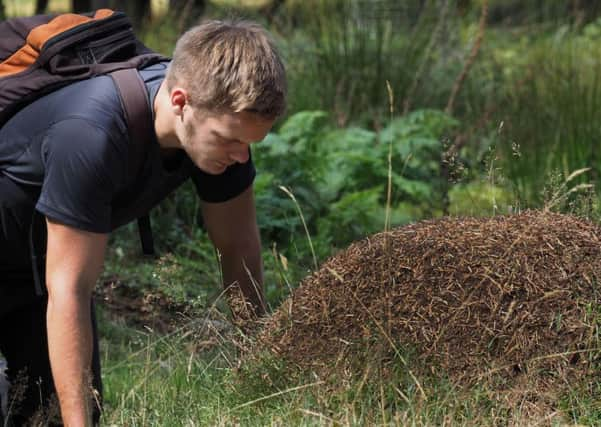Scientists '˜monitoring' hundreds of metre-wide ant colonies discovered in part of Sheffield


Biologists have been observing more than 900 ant nests around the Longshaw Estate in the Peak District over the last five years.
It is one of the country’s largest colonies of northern hairy wood ants and the nests range in size from a tennis ball to metre-wide ant cities.
Advertisement
Hide AdAdvertisement
Hide AdScientists found that these ant cities contain special chambers and tunnels and a network of trails between nests and feeding sites, where the ants milk honeydew from their herds of aphids in nearby trees.
Biologist Courtney Rockenbach, originally from New Jersey who is part of the York University scientific team conducting the research, has been impressed with what she has seen so far.
She said: “Ants sometimes get a bad reputation, but I think anytime we can appreciate the complexity of an organism, we gain a little more respect for it.”
The scientists have monitored wood ant movement by marking them with special paint, and by fitting ants with tiny transmitters to log their travels along a complex network of two inch wide trails worn through the Longshaw grass by thousands of ant feet, and the formic acid excreted by the insects. They found that the nests - which each house a closely related family of ants - co-operate to share food with nearby nests of the same family.
Advertisement
Hide AdAdvertisement
Hide AdResearcher Dr Elva Robinson said: “It’s a buffering strategy. If there are many nests all exploring for food, a nest doing well can support a nest temporarily not doing well, and then there might come a time that the food goes back the other way.”
Longshaw’s owners the National Trust work closely with the scientists, and ranger Rachel Bennett said the findings help inform the woodland and tree removal strategy.
The latest work is centred around another recently discovered resident of the ant cities: the tiny ‘shining guest ant.’
Dr Robinson added: “Really it’s an unwanted guest in the nest, you could think of it like a house mouse.
Advertisement
Hide AdAdvertisement
Hide Ad“At a few millimetres long, guest ants are less than half the size of a hairy wood ant, but scurry around picking up discarded food in the nest, protected by tasting horrible to wood ants.
“At present, any benefit to the host wood ants from this arrangement is unclear, but could not be ruled out.”
From now until mid October, the Longshaw ranger team is inviting applications from members of the public to join the guest ant researchers in their work.
Ant monitors will be given the tools and training to record which nests have shining guests in residence.
Advertisement
Hide AdAdvertisement
Hide AdGeorge Talbot, a student at King Edward VII School in Broomhill, who helped with the first monitoring session in September, said: “Citizen science like this spreads awareness and helps people understand what’s going on in their own area. I’ve really enjoyed taking part, but I think I’ve been bitten under my shirt, on my head, everywhere.”
George’s dad Ted, who is the National Trust countryside manager for the Peak District, said: “The northern hairy wood ant is a very special animal in the Peak District, and Sheffield people know about it because if you sit down in the wrong place and have a picnic, they climb up your leg. But we certainly don’t yet know everything about hairy wood ants and this guest who lives alongside them. If you do want to contribute to groundbreaking research you don’t have to go the Amazon rainforest, you can do it here at Longshaw.”
Email [email protected]